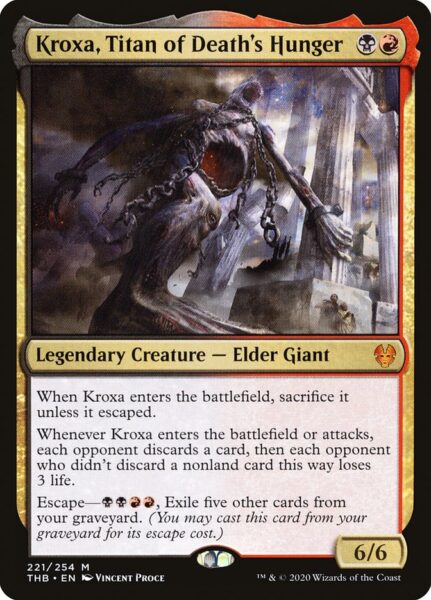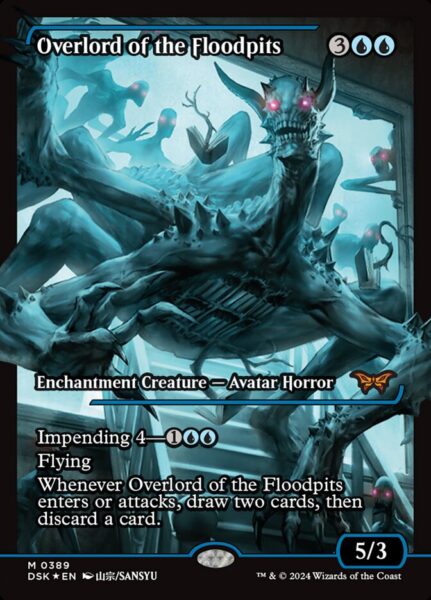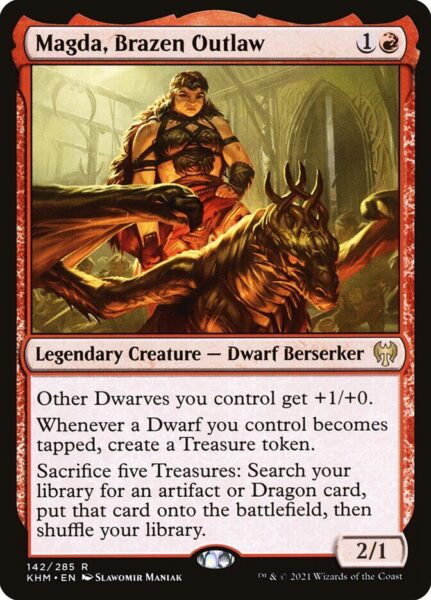by Johnny Cycles, November 1st, 2024

What’s scarier than a big floating eye? Will we manifest enough dread in our opponents to grind out some wins? Let’s find out!
How to Build Around the Eye
There are two general ways we can build around this new mythic from Duskmourn: House of Horror. We can build a graveyard deck, similar to Vengevine in Modern, that tries to fill its yard as fast as possible in order to cast this 3-mana 5/5 as early as turn 3.
Or, we can play a fair, Midrange or Control strategy that fills the graveyard naturally with cheap interaction and card draw and casts Abhorrent Oculus in the late game, ideally with protection up.
Will either strategy be good enough in Pioneer? I’m going to give both versions a whirl!
Decklist – Grixis Eye
by Johnny Cycles
Format: Pioneer
Creatures (26)
| 4 Bloodsoaked Champion | |
| 4 Stitcher’s Supplier | |
| 4 Undead Sprinter | |
| 4 Abhorrent Oculus | |
| 3 Flamewake Phoenix | |
| 4 Overlord of the Floodpits | |
| 3 Overlord of the Balemurk |
Spells (8)
| 4 Fatal Push | |
| 4 Torch the Tower |
Enchantments (3)
| 3 Bitter Reunion |
Lands (23)
Sideboard (15)
| 4 Duress | |
| 3 Go for the Throat | |
| 3 Brotherhood’s End | |
| 1 Nicol Bolas, the Ravager | |
| 4 Glorybringer |
Deck Tech
Primary Game Plan
We’re first and foremost looking to fill our graveyard as quickly as possible in order to get Abhorrent Oculus out as early as turn 3. The 5/5 evasive body presents a fast clock, but what really allows us to run away with games is manifesting dread each turn (opponent’s upkeep). Not only does this amass an army, it also helps us refill our graveyard in order to cast a second Abhorrent Oculus.
Stitcher’s Supplier and Overlord of the Balemurk are our most efficient ways of filling the graveyard, while Bitter Reunion and Overlord of the Floodpits help us find Abhorrent Oculus (or whatever we need in the moment). And, honestly, Abhorrent Oculus is not just the card we wanted to build around; it’s the best card in the deck. Many of the games we’ve won have come as a direct result of the flying eye and its army of 2/2s.
Supporting our graveyard strategy we have a hodgepodge group of recursive threats that allow us to get value both from our self-milling and from our manifesting dread. Being able to cast these threats from the graveyard gives us another angle of attack, should we not find our Abhorrent Oculus. We can also have some aggressive starts with the right draw that will put our opponent on the back foot.
The rest of our deck is made up of removal. Our sideboard gives us more spot removal, Duress to disrupt our opponent’s game plan and hopefully snag a Rest in Peace before it ruins our fun, and Brotherhood’s End for Aggro decks.
Our real spice comes in the form of Dragons! Of course, this should come as no surprise, but there is a reason other than my love for the tribe.
Fighting the Graveyard Hate
Shutting down our graveyard with Leyline of the Void or Rest in Peace can leave us durdling with a literal dead card in hand, since we can’t cast Abhorrent Oculus without our graveyard. So against decks that I think will bring in such hate, I cut the Eye and replace it with Glorybringer!
Nerfing our ability to recast Bloodsoaked Champion or Undead Sprinter is annoying, but we aren’t really expecting them to close out games by themselves. We are, however, leaning hard on Abhorrent Oculus to grind out victories, so we need a viable and sufficiently powerful replacement for it against the sideboard graveyard hate most people will have thanks to Izzet Phoenix’s popularity.
Practice Match 1 vs. Mono White Humans
Practice Match 2 vs. Landfall
Overall Impressions
The deck is super fun, but it had some unexpected challenges. First, the mana base proved more problematic than I expected. Looking at the deck, we really only need double early. The rest of our cards are single pips.
The reality, though, is that Undead Sprinter is color intensive at . For our more aggressive starts, then, we want both of these colors online by turn 2, as well as double to set up Overlord of the Floodpits on turn 3. Furthermore, in order to get the most value out of Undead Sprinter, we really need double or double in order to cast a kill spell and recast the Zombie in the same turn.
Mistakes in tapping and surveiling away lands were the first hurdles I encountered with our mana. The next was the usual suspect of mana screw. I eventually added an additional land, but missing land drops is just as painful with our deck as with any other.
The next challenge we encountered was in our threats. Given that I wanted to find recursive threats so as to gain additional value from milling ourselves, we are playing some fairly underwhelming beaters. Pioneer has neither the power nor the ability to flood the board that Modern’s Vengevine offers. Thus, we were left recurring some 2/1s and 3/3s in the late game when our opponents were resolving Adeline, Resplendent Cathar or Archfiend of the Dross.
This gameplan can work if we curve out into an early Abhorrent Oculus backed up by one of our Overlords, but more often than not, I felt like what we were doing just wasn’t on par with the power of our opponent’s plays. I’ve posted only two videos, in part, for this reason. The other is that we ran into a lot of Mono White and watching the same match-up over and over isn’t much fun.
Increasing the Power Level
What if we take out our weak, but recursive threats and replace them with some of the best cards in the format?
One issue with the above version of the deck is that without Abhorrent Oculus, we were left filling our graveyard and playing a bunch of underwhelming creatures.
Enter Kroxa, Titan of Death’s Hunger.
This Elder Giant solves two problems for us. It simultaneously increases our power level and gives us another must-answer threat that we can easily cast using our graveyard.
Meanwhile, Fable of the Mirror-Breaker replaces Flamewake Phoenix as a way to fill our graveyard while digging for the Eye. Reflection of Kiki-Jiki can double our big threats and close out a game quickly.
Sheoldred, the Apocalypse gives us some much needed lifegain and another must-answer threat that synergizes with all of our card draw.

Mindwrack Demon is more than a guilty pleasure in this deck. It quickly refills our graveyard for another Abhorrent Oculus or Kroxa, while its 4/5 evasive, trampling body is another threat that can close out games quickly. Of course, now that Archfiend of the Dross exists, this mythic from Shadows over Innistrad is not quite as impressive. But given its synergies with the rest of our deck, it deserves a spot over the bigger, badder rare from Phyrexia: All Will Be One.
Otherwise, I’ve cut some removal, added Consider to smooth out our draws and fill the graveyard, and tweaked the sideboard to shore up some of the match-ups I’m expecting.
Deck Tech
Decklist – Grixis Eye
by Johnny Cycles
Format: Pioneer
Creatures (23)
| 4 Stitcher’s Supplier | |
| 3 Kroxa, Titan of Death’s Hunger | |
| 4 Abhorrent Oculus | |
| 2 Mindwrack Demon | |
| 2 Sheoldred, the Apocalypse | |
| 4 Overlord of the Floodpits | |
| 4 Overlord of the Balemurk |
Spells (10)
| 4 Consider | |
| 2 Fatal Push | |
| 2 Torch the Tower | |
| 2 Go for the Throat |
Enchantments (4)
| 4 Fable of the Mirror-Breaker |
Lands (23)
Sideboard (15)
| 2 Thoughtseize | |
| 2 Sheoldred’s Edict | |
| 3 Brotherhood’s End | |
| 4 Leyline of the Void | |
| 4 Glorybringer |
Match 1 vs. Mono White Humans
Match 2 vs. Rakdos Midrange
Match 3 vs. Mono Red
Match 4 vs. Orzhov Tokens
Match 5 vs. Mono Green
Match 6 vs. Izzet Phoenix
Match 7 vs. Mono Blue Spirits
Final Record: 4-3
Overall Impressions, Part II
The increase in power level felt, well, powerful. The addition of Kroxa, Titan of Death’s Hunger filled a void in the deck, just as I had anticipated. Having another massive, game-ending threat that we can recur from the graveyard meant we rarely, if ever, had a full yard and nothing to do with it.
Furthermore, and something I didn’t explicitly expect, Kroxa gave us something to discard to Fable of the Mirror-Breaker or Overlord of the Floodpits. In a Midrange deck like this one, we often don’t want to discard our non-land spells unless we’re digging for a land or an answer to the board. With Kroxa, we don’t have to make any hard choices. We can pitch it and get it back the same turn with Fable of the Mirror-Breaker. And, more often than not, we’d rather have it in the yard.
Sheoldred, the Apocalypse was another obvious upgrade. Her synergy with all of our card draw is powerful, while she punishes some of the more popular decks like Izzet Phoenix and Mono Green, both of which want to draw a lot of cards in their own way.
Finally, Fable of the Mirror-Breaker really shines in our deck. Untapping with it on turn 4 allows us not just to dig for what we need, but also to cast Abhorrent Oculus. Our Overlords are also both 5 mana, so if we can attack once with the Goblin Shaman token and make a land drop on turn 4, then we can get down one of our big threats a turn early.
Besides the obvious upgrades to our janky version of the deck these changes resulted in, the most important impact these cards had was in letting our core strategy shine. In essence, we are looking to fill our graveyard as rapidly as possible in order to stick an early Abhorrent Oculus. In our janky version, our deck kind of floundered when we didn’t execute this gameplan.
In this version, though, we were doing individually powerful things that our opponent had to deal with on our way to resolving an Abhorrent Oculus. Oftentimes, we played Kroxa or our Overlords and won that way. In many post-board games, we didn’t even have the Abhorrent Oculus in our deck and still won.
Weaknesses
We had a hard time against Aggro, whether it be Humans, Burn, or Prowess. We can make room for either more spot removal or a few copies of Brotherhood’s End to help against those decks.
Being a Midrange strategy looking to abuse our graveyard means there will be some games in which we straight up durdle for several turns before sticking a single big threat, only to have our opponent answer it or win through it. We saw this a lot in the Aggro match-ups, but even Mono Green beat us one game in which we did a lot, but didn’t commit any threats to the board.
Since we can be slow setting up, our opponents will have plenty of time to execute their own strategies or find what they need to deal with ours.
Finally, being in three colors came back to haunt us, particularly in post-board games when we really wanted a second red source. I tweaked the mana base along the way, but it’s possible a 24th land is the right decision.
Changes Going Forward
As much as it pains my janky heart to say it, Mindwrack Demon should probably be cut for more removal. It does fill our graveyard to cast an Abhorrent Oculus, but the two are more often than not non-bos.
Conclusion
While the deck gets its name from the 3-mana mythic Eye, it would be unfair of me not to reiterate how powerful the Overlords were in the deck. Both synergize beautifully with Abhorrent Oculus, of course, but as threats of their own, they are must-answer value engines that can close out games quickly.
Again and again I was blown away by Overlord of the Balemurk and its ability to get us back any non-Avatar creature from our graveyard (not just from among the cards we mill). In stalled out games, this Overlord was almost as good at giving us the advantage as Abhorrent Oculus. The 5/5 body is hard for a lot of decks to deal with, as well.
Meanwhile, Overlord of the Floodpits does a pretty good Fable of the Mirror-Breaker impression as an enchantment. As a creature, the card advantage we get from attacking with it is almost win-more, to be honest. What’s most impressive and somewhat overlooked, I think, is the evasion. Hitting for 5 in the air, particularly in conjunction with Abhorrent Oculus, is a 2-turn clock against any but Lifegain decks.
If I had to say just one thing about this deck it is this: the grinding value alone makes it worth playing. Our most fun games happened when we were doing it all with Duskmourn: House of Horror mythics – manifesting dread, milling and getting something from the yard, and drawing through our deck. In those moments, the deck felt unbeatable. And, even when we still lost, as we did against Izzet Phoenix, there was no denying the power and the fun of this deck’s synergies.
So if you’re looking for a powerful new deck that can compete with the format’s best, then give Abhorrent Oculus and Friends a chance. I think you’ll be impressed and surprised at all the fun synergies, powerful plays, and complicated lines you’ll find.
As always, thanks for reading and watching!













